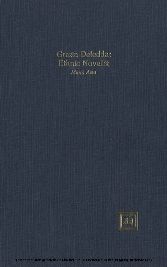Suchen und Finden
Introduction (p. 4)
Grazia Deledda was born into a middle-class family in Nuoro, Sardinia, on September 27, 1871. The house where she was born is still standing and thé street is now called, in her honor, Via Grazia Deledda. Deledda`s family was affected by ail thé psychological problems and préjudices of a typical Sardanian middle-class family of thé time.
Deledda finished her formai éducation at thé age of 11, after primary school, as a woman, according to custom, she was not permitted to continue on to high school or university studies. However, she compensated for this lack of éducation by becoming an avid reader of nineteenth-century fiction, both Italian and Européen.
In thé novel Cosima, published posthumously in 1937, Deledda reflects with touching sincerity upon thé hardships of her young life in Sardinia at thé turn of thé century.
In 1886, at the age of 15, Deledda published her first short story, and in 1888 she became a regular contributor of short stories to the magazine Ultima Moda, thus acquiring a certain notoriety in her native city. These early Works were set in thé Sardinian locale that was to become identified with Deledda`s greatest writings.
Thèse stories were also written at a time when her family was experiencing several difficulties caused by thé irresponsible behavior of her two oldest brothers—Andréa, who was arrested, and Santus, thé firstborn who became an alcoholic and later suffered from insanity. In 1892 Deledda`s father died following a stroke.
Enza, thé older sister, also died soon after her wedding, while another sister, Giovanna, died while Grazia was still in her youth. Another younger sister was betrothed to a school inspecter much older than herself, who was primarily interested in her dowry. Fortunately for thé sister, thé school inspecter died before thé wedding could take place.
During this very difficult period, Deledda acquired graduai and progressive maturity as a writer. Her literary activity became more prolific, and her efforts soon began to gain récognition. During this period she wrote For di Sardegna (1882) and La giustizia (1899), which, like her other youthful work reflect a sentimental style based on thé realistic observation of nature and thé people around her.
Meanwhile, Deledda was also adding to her réputation by collaborating with De Gubernatis in thé collection and publication of thé folkloric traditions of her people and town in thé shortlived Riuista di Letteratura Popolare. A ray of light in Deledda`s life as a writer came not only with thé publication of Anime aneste (1895), but especially with Luigi Capuana`s introduction to her novel, La via del mâle (1896).
In his admiring essay Capuana profiles Deledda as a régional writer in thé tradition of "verismo." This introduction was to become instrumental in bringing attention to Deledda`s works outside of Sardinia. In 1899 Deledda left Nuoro for thé first time and settled in thé capital city of Sardinia, Cagliari, where she would meet her future husband, Palmiro Modesani, a civil servant.
Deledda and Modesani were married in 1900, and immediately thé couple moved to Rome, where Deledda would spend thé rest of her life, and where she was to establish an international réputation as a novelist.
Alle Preise verstehen sich inklusive der gesetzlichen MwSt.








